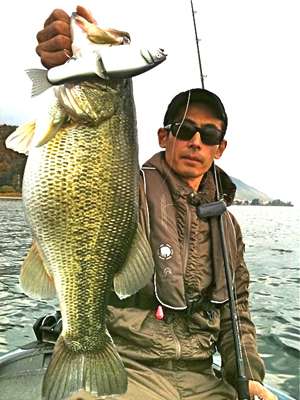
If you’re like the average American, $400 would make your life a tad easier. You could pay a bill or two, save it for a rainy day, or fund a fancy outing for you and your significant other. Or, if you’re addicted to trophy bass hunting and your spouse didn’t know about the cash, you could buy one of the most expensive swimbaits ever devised, Roman Made’s Mother.
Now, purchasing a swimbait that is made for catching big bass – no matter what you paid for it – is no guarantee you’ll catch a “teener” (13 pounds or heavier) or even a 5-pounder. This is likened to having lots of tools but no idea how to rebuild a small-block Chevy; having the equipment doesn’t guarantee success. But, it does help.
“The action in each model comes from solid research of trophy bass behavioral responses to predatory and territorial stimulus,” the Roman Made website says of the Mother. “Handmade from hues to materials, all possess exquisite quality and attention to detail.”
Each Roman Made Mother swimbait takes roughly 12 hours to build. The Mother – Roman Made’s biggest bait – weighs in at 10-plus ounces and stretches nearly 12 inches. A half dozen craftsmen work full time making the swimbait line, and attention to detail is what makes these gems different. The baits are made with wood that Toshinori Takeyama – Roman Made’s founder – himself selects. Even within the same species of wood, the densities can be different enough to impart undesired action and results in the end product. As expected, premium hooks, split rings and paint are used as well.
Roman Made baits are proven on Lake Biwa, where world-record holder Manabu Kurita fought and lost a fish that he estimates in the 28-pound range on a Mother.
David Swendseid, Product Specialist Manager for Jackall Lure Co., has dealt with JDM (Japanese domestic manufactured) baits for nearly two decades, and his experience with Japanese manufacturers made him the ideal liaison between Kurita and American buyers interested in buying the mounted bass. He’s intimately familiar with Roman Made’s baits and more importantly, how to fish them.
Swendseid says that one of the things that inventor Takeyama wanted to achieve was a bait that never quit moving, even when paused in the water. He accomplished this by perfectly balancing the bait and angling the joints so that when the retrieve was stopped, the bait straightened out and gently wafted to the bottom. Most swimbaits “crump,” or bunch up and nose dive to the bottom when paused, taking away a dimension of realism. Takeyama believes that Roman Made baits are as close to “perpetual motion” as possible.
Roman Made
Roman Made is a small company headquartered in Shiga Prefecture, Japan, near Lake Biwa. Takeyama started the company as a fulfillment of a lifelong dream to mimic bass’ prey as closely as possible. He grew up near a stream where he became fascinated with black bass after catching one on a Hula Popper, a bait he thought he could improve on.
“The bait only had one dimension of movement and one way to make a fish strike,” he recalls. Takeyama wanted a bait that moved freely and was natural regardless of what it was doing. He wanted effortless motion.
Gear
While your flipping stick might suffice to throw the smaller, 7- to 8-inch Roman Mades, according to Takeyama, heaving the Mother swimbait requires a custom-made stick. That’s why he designed a complementing line of rods under the name Centurion. They carry an eye-popping price tag, too ($589.99 – $599.99). There are two rods, one for the smaller baits and one specifically for the Mother. The actions of these rods are tailor-made to match Roman Made’s baits. For the smaller baits, 16- to 25-pound-test line is recommended, while you’d be wise to throw the Mother on 30-pound fluorocarbon.
Fishing with big baits takes lots of patience. You’ve got to invest time into the hunt to be successful, and for trophy bass hunters, that means lots of bass that follow plus-size offerings.
“That’s just part of the game,” Swendseid says. “Sometimes if I get a bass to follow my lure, I’ll leave the area and come back later and approach it from a different angle, and lots of times that’s all it takes to get them to bite.”
For more information please visit our photo gallery or RomanMade.com.




